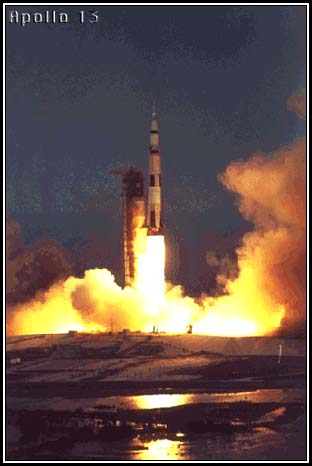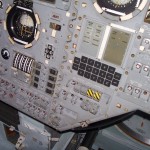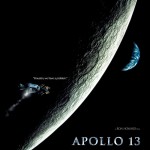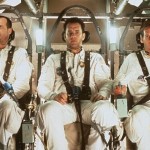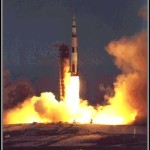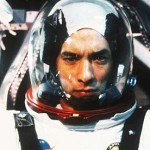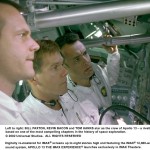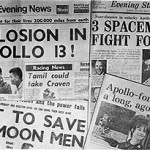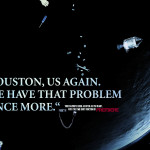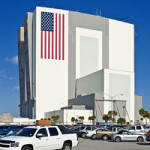I’m going to mark this one down as a biopic – or rather docudrama, in that in tells in dramatised format the true story of the ill-fated moon-bound space craft and its miraculous return to earth with all hands still alive. The fact that you know the outcome in advance does not make this tale any the less gripping. For the record, these are the events depicted in the movie, recounted by Wikipedia:
On July 20, 1969, veteran astronaut Jim Lovell (Tom Hanks) hosts a party for other astronauts and their families, who watch on television as their colleague Neil Armstrong takes his first steps on the Moon during theApollo 11 mission. Lovell, who orbited the Moon on Apollo 8, tells his wife Marilyn (Kathleen Quinlan) that he intends to return, to walk on its surface.
On October 30, while giving a VIP tour of NASA’s Vehicle Assembly Building, Lovell is informed by his boss Deke Slayton that he and his crew will fly the Apollo 13 mission instead of Apollo 14. Lovell, Ken Mattingly (Gary Sinise), and Fred Haise (Bill Paxton) begin training for their new mission. Days before launch, it is discovered that Mattingly was exposed to measles, and the flight surgeon demands his replacement with Mattingly’s backup, Jack Swigert (Kevin Bacon), as a safety precaution. Lovell resists breaking up his team, but relents after Slayton gives him the choice of either accepting the switch, or else being bumped to a later mission.
As the launch date approaches, Marilyn’s fears for her husband’s safety manifest in nightmares, but she goes to Cape Kennedy the night before launch, to see him off despite her misgivings.
On April 11, 1970, Apollo 13 Flight Director Gene Kranz (Ed Harris) gives the go-ahead from Houston’s Mission Control Center for launch. As the Saturn V rocket climbs into the sky, an engine on the second stage cuts off prematurely, but the craft successfully reaches Earth orbit. After the third stage fires, sending Apollo 13 on a trajectory to the Moon, Swigert docks the Command/Service Module Odyssey with the Lunar ModuleAquarius, and pulls it away from the spent stage.
Three days into the mission, the crew send a live television transmission from Odyssey, but the networks, believing the public now regards lunar missions as routine, decline to carry the broadcast live. Swigert is told to perform a standard housekeeping procedure of stirring the two liquid oxygen tanks in the Service Module. When he flips the switch, one tank explodes, emptying its contents into space and sending the craft tumbling. The other tank is soon found to be leaking, prompting Mission Control to abort the Moon landing, and forcing Lovell and Haise to hurriedly power up Aquarius as a “lifeboat” for the return home, while Swigert shuts down Odyssey before its battery power runs out. On Earth, Kranz rallies his team to do what is necessary to get the astronauts home safely, declaring “failure is not an option.” Controller John Aaron recruits Mattingly to help him figure out how to restart Odyssey for the final return to Earth.
As Swigert and Haise watch the Moon passing beneath them, Lovell laments his lost chance of walking on its surface, then turns their attention to the task of getting home. With Aquarius running on minimum systems to conserve power, the crew is soon subjected to freezing conditions. Swigert suspects Mission Control is unable to get them home and is withholding this from them. In a fit of rage, Haise blames Swigert’s inexperience for the accident; the ensuing argument is quickly squelched by Lovell. When the carbon dioxide exhaled by the astronauts reaches the Lunar Module’s filter capacity and approaches dangerous levels, an engineering team quickly invents a way to make the Command Module’s square filters work in the Lunar Module’s round receptacles. With the guidance systems on Aquarius shut down, and despite Haise’s fever and miserable living conditions, the crew succeeds in making a difficult but vital course correction by manually igniting the Lunar Module’s engine.
Mattingly and Aaron struggle to find a way to power up the Command Module with its limited available power, but finally succeed and transmit the procedures to Swigert, who successfully restarts Odyssey by transmitting extra power from Aquarius. When the Service Module is jettisoned, the crew finally see the extent of the damage and prepare for re-entry, unsure whether Odyssey’s heat shield is intact. If it is not, they will burn up. They release Aquarius and re-enter the Earth’s atmosphere in Odyssey. After a tense, longer than normal period of radio silence due to ionization blackout, the astronauts report all is well and splash down in the Pacific Ocean. The three men are brought aboard the aircraft carrier USS Iwo Jima.
As the astronauts are given a hero’s welcome on deck, Lovell’s narration describes the events that follow their return from space—including the investigation into the explosion, and the subsequent careers and lives of Haise, Swigert, Mattingly and Kranz—and ends wondering when mankind will return to the Moon.
Given the nature of the source material, you can imagine a similar movie to Apollo 13 being made as a 60s B-movie with thoroughly unconvincing special effects and a general cheesiness. In fact, this movie is neither: everything about it is credible and recreated technically with painstaking sincerity including, thanks to the countless high-altitude plane loops conducted by cast and crew – many shots of weightless adventures in the reconstructed command and moon vehicles. Even the space model shots are a cut above the average. Full marks especially for every shot being original, with no stock mission footage added as a makeweight.
As for the cheesy bit, that is an even more difficult trick to pull off. There is a wafer thin line between the usual Hollywood schmaltz with patently false emotions and American derring-do and telling the facts straight. Almost always, the movie industry will try to whip up a drama out of a crisis, but credit to Ron Howard for keeping the movie on an even keel, even though there are moments when the dramatisation of this tale becomes obvious. Even then, we could have done without the syrupy music to accompany emotionally sensitive moments: less is often more.
Due credit here to sensitive handling by the cast. At no point do you ever get that docu-drama moment when the characters seem to be sending themselves up or speaking in clichés, which is, I suspect, a much harder trick to pull than at first appears. The truly memorable lines in this script were all real and much-quoted, “Houston, we have a problem” (which is actually a slight paraphrase) and “Failure is not an option” (which was actually in an email, not spoken) among them – though I suspect if we were to be embroiled in such a dramatic situation, we might all begin to talk in clichés anyway.
Actually, the script is a joy, with many excellent one-liners along the way. It also steers a course between explaining what was going wrong and the technical debate raging among the ground crew in Houston, and being overly simplistic in order to avoid losing the audience. If House is evidence, if evidence were needed, that you can conduct an incomprehensible debate without losing any of the urgency of a compelling drama, then Apollo 13 got there first.
Tom Hanks, for all his two Oscars and “nice guy” clean cut image, does not always win me over – possibly because the nice guy bit is overdone on occasions. Here, his Jim Lovell is flawed but a consummate professional, doing what has to be done in a cool and clinical fashion while at the same time thinking of his family back on earth and the very real possibility that he may die out there and not be a father to his young kids. This he handles with dignity.
Hanks is ably supported by Kevin Bacon, Gary Sinise and Bill Paxton, though the families and women in particular seem to be there largely for hand-wringing purposes, NASA being a high octane macho environment, barely a woman to be seen. I have no doubt that was reality, though for Hollywood purposes a weeping woman is good cinema.
The NASA control room, meanwhile, becomes a sweaty, smoky, claustrophobic theatre in which the events are played out, pictures from space and disembodied voices relaying new information by the minute. The tension ratchets up as the problems are uncovered and each moment contains new ways in which the tin box in space can become a floating coffin for the three crew members.
Arguably the finest moment of the movie is where a disconnect between the CO2 filters in the two modules leaves a group of NASA staff with the job of creating a filter from the odds and ends available to the crew – bits of tubing, plastic boxes and masking tape for the most part. They plonk their device on a controller’s desk with an air of grim defiance, while he barks out terse orders for the procedure notes on how it should be created.
Then there are the moments when the crew are out of signal. Firstly as they slingshot around the dark side of the moon, but more tellingly when they cascade through the earth’s atmosphere in the hope their angle of entry is correct, the heat shield holds out and they are not burned to the proverbial crisp. Then… the moment of relief on every face as the module appears on the monitors. This is a common moment in movies when the instinct for ham acting takes over, though in spite of the weepie moment Howard avoids the temptation to overplay the scene.
The movie was very well received by critics and public alike. Ironic then that the only gong won by Apollo 13 at the Oscars was for film editing and sound mixing, in spite of 9 nominations. However the final word must go to the feedback from one viewer at a test screening:
Ron Howard stated that, after the first test preview of the film, one of the comment cards indicated “total disdain”; the audience member had written that it was a “typical Hollywood” ending and that the crew would never have survived.
How often does real life surpass everything that can be created in the movie industry?

